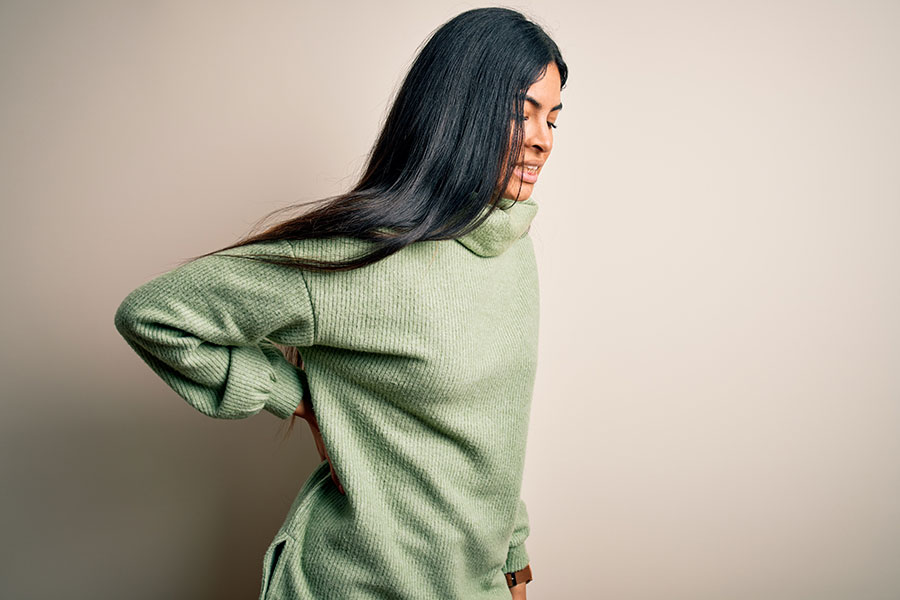When you think about back pain, your feet probably aren’t the first thing that comes to mind. However, your feet play a crucial role in how your body moves and functions, and problems with your feet can lead to or exacerbate back pain.
There are many caused to back pain. Lower Back pain in particular, can also be caused by an incorrect position of the feet or an abnormal walking pattern.
When your feet are collapsed and your ankles roll inwards (known as ‘excess pronation), the entire body becomes unbalanced and the muscles in the (lower) back are being overloaded. The body will start correcting the wrong posture somewhere, and usually this is in the back.
Whether you’re dealing with fallen arches and mis-aligned ankles , or when wearing the wrong shoes (with little support), your feet could be contributing to your discomfort!
Leg length difference
A leg length difference can also cause back pain. However, a leg length difference can have several causes. One leg may actually be shorter than the other by a few centimeters. But the pelvis may also be tilted when one foot ‘sags’ more than the other. This is known in medical terms as a ‘functional short leg’. I will lead to curvature of the spine, resulting in chronic back pain.
The Link Between Feet and Back Pain
Your feet are complex structures made up of bones, muscles, ligaments, and tendons that support your body’s weight. If your feet are out of alignment or don’t function properly, it can affect your entire posture and gait, leading to back pain.
Simply put, when your feet aren’t aligned correctly, it can cause a chain reaction of stress and strain up your body, eventually reaching your back.
The body works as a holistic system: each part depends on the others. When your feet are misaligned, you will experience stress on your knees, hips, and lower back. Over time, this stress can lead to muscle fatigue, discomfort, and chronic pain.
Common foot issues that may lead to back issues:
1. Flat Feet (Over-pronation)
Flat feet, or fallen arches, occur when the arches of your feet collapse, causing them to roll inward. This misalignment puts extra stress on the knees, hips, and lower back. The resulting imbalance can lead to discomfort as your body compensates for the poor foot alignment.
2. High Arches (Supination)
High arches, in which the foot doesn’t absorb shock as well, can lead to supination—where your feet roll outward. This can affect your body’s alignment and cause pressure on your lower back, as the lack of shock absorption forces other parts of the body to absorb the impact.
3. Heel Spurs and Plantar Fasciitis
Heel spurs, often associated with plantar fasciitis, can cause significant discomfort and alter the way you walk. When you have heel pain, you might subconsciously change your gait to avoid aggravating the condition, which can lead to back pain from the resulting misalignment.
4. Poor Footwear
Shoes that lack support or cushioning—such as high heels, flip-flops, or shoes with little arch support—can contribute to foot problems that impact your back. When shoes don’t provide proper support, your posture and gait are affected. In turn this can cause pain in the lower pain.
Steps you can take to help relieve foot-related back complaints
1. Wear Supportive Shoes
Choose shoes with good arch support, cushioning, and stability. Avoid high heels, flip-flops, or shoes that don’t offer proper support. A well-fitting pair of shoes can go a long way in helping to maintain proper posture and reduce stress on your back.
2. Consider Custom Orthotics
Custom orthotic insoles can help correct misalignments, especially if you have flat feet or high arches. Orthotics help redistribute the pressure across your feet, providing better alignment and reducing strain on your back.
3. Stretch and Strengthen Your Feet
Strengthening the muscles in your feet and calves can help improve your posture and reduce strain on your lower back. Simple exercises like toe curls, calf raises, and foot stretches can help support your body’s natural alignment.
4. Check Your Posture
Good posture starts from the ground up. Be mindful of how you stand and sit. When standing, try to distribute your weight evenly across your feet. Avoid slouching when sitting, and make sure your feet are flat on the floor. Proper posture can alleviate unnecessary strain on your back.
5. Consult a Specialist
If you’re experiencing persistent back pain and suspect your feet are to blame, consider seeing a physical therapist or a foot specialist (podiatrist). They can evaluate your foot structure, gait, and posture to determine if your feet are contributing to your back pain and recommend appropriate treatments.
What is a herniated disc?
Your back is supported by the spinal column, which is made up of ‘vertebrae stacked on top of each other. These vertebrae make the spine sturdy and strong so you stay upright and don’t collapse.
Between the vertebrae are discs called intervertebral discs. These discs absorb shocks and smoothly guide the movements of the spine.
In the centre of an intervertebral disc is a soft gel. If this gel starts to bulge, it can press against the nerve pathway. The nerves become irritated and this is usually accompanied by annoying pain. Most herniated discs occur in the low back.
Conclusion
Everyone’s back hurts once in a while, but many people suffer from unexplained back pain several times a week. A stiff, nagging or tired feeling is the most common complaint. They are often non-specific back pain, meaning that no physical cause is found in the back. In this case, taking a look at your feet could be helpful…
Your feet and back are more connected than you might think. Issues with foot alignment, poor footwear, or specific foot conditions like flat feet or high arches can lead to long-term back pain.
Fortunately, by taking proactive steps to support your feet—such as wearing the right shoes, using arch supports and doing foot-strengthening exercises—you can help reduce the strain on your back and improve your overall body posture.
If you’ve been struggling with back pain, don’t forget to consider your feet. They might be the key to finding relief and improving your daily quality of life.






